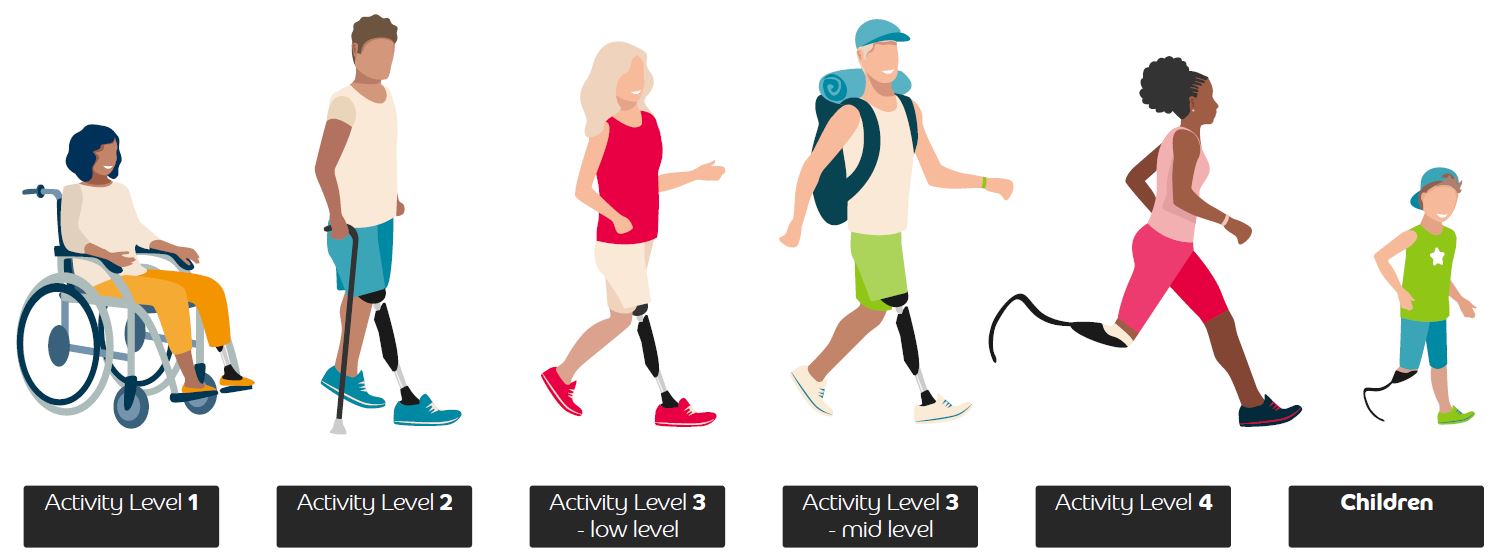Laura Ritchie - Understanding K-Level Classification in Prosthetics
Posted on Thursday, February 29, 2024
K-Level Classifications: A Guide for Patients and Practitioners
 Laura Ritchie
Laura Ritchie
Prosthetist
In prosthetics, the K-Level classification system is one of the critical frameworks used to assess an individual's mobility and activity levels. K-Levels, short for "Knee Levels," provide a standardised way for clinicians to gauge a person's functional capabilities and tailor prosthetic interventions accordingly. Whether you're a patient navigating your prosthetic journey or a prosthetist tasked with optimising patient care, understanding K-Levels is crucial. So, let's delve into what K-Levels are and what they signify in the world of prosthetics.
What are K-Levels?
K-Levels are a set of five classification levels that denote varying degrees of mobility and activity. Originally developed to aid clinicians in assessing prosthetic needs, K-Levels have become a universal language in prosthetics, facilitating effective communication among practitioners, physiotherapists, and patients worldwide.
The Five K-Levels:
K0: This level signifies non-ambulatory individuals relying primarily on wheelchairs for mobility. While they may be able to transfer from one surface to another, their ability to mobilise independently is severely limited.
K1: Individuals at this level are considered functional for indoor ambulation with assistive devices like walkers or canes. They can navigate basic indoor environments but may face challenges regarding more complex terrains or outdoor activities.
K2: This level encompasses individuals with limited outdoor ambulation capabilities. While they can manage flat surfaces and negotiate mild obstacles, they may require additional support, such as walking aids, to maintain stability and mobility.
K3: Considered the standard or "normal" level of mobility, individuals at K3 can ambulate without significant limitations. They can navigate various terrains, change speeds, and quickly negotiate obstacles.
K4: Reserved for individuals engaging in high-impact activities or sports, K4 represents the highest level of functional mobility. These individuals often require prosthetic solutions tailored to withstand rigorous physical demands and provide optimal performance during dynamic activities.
Assessing K-Levels:
Determining a patient's K-Level involves a comprehensive evaluation by prosthetists and multidisciplinary teams. Factors such as the patient's medical history, mobility goals, physical capabilities, and lifestyle preferences are considered during the assessment. This holistic approach ensures that prosthetic interventions align with the individual's needs and aspirations.
Laura Ritchie, a Blatchford prosthetist, emphasises the importance of this comprehensive approach, stating, "Assessing K-Levels involves more than just evaluating physical abilities. We delve into patients' histories, goals, and aspirations to ensure we provide prosthetic solutions that enhance their quality of life."
Ritchie further explains, "By understanding a patient's K-Level, we can tailor prosthetic components to meet their needs and aspirations. Whether providing stability for outdoor ambulation or enhancing performance for high-impact activities, we aim to empower patients to live life to the fullest."

Matching Products to K-Levels:
When selecting prosthetic components, prosthetists consider the patient's assessed K-Level to ensure optimal functionality and comfort. Here's a brief overview of how prosthetic products align with different K-Levels:
K0/K1: Basic prosthetic solutions focused on facilitating transfers and indoor mobility.
K2: Prosthetic components offering enhanced stability and support for outdoor ambulation, often incorporating walking aids.
K3: Versatile prosthetic systems designed to accommodate various activities and terrains, providing optimal mobility and control.
Specialised prosthetic devices engineered to withstand high-impact activities and dynamic movements, delivering exceptional performance and durability.
Conclusion:
In the dynamic world of prosthetics, K-Levels serve as a guiding framework for assessing and addressing the diverse mobility needs of individuals with limb loss. By understanding the significance of K-Levels and their implications for prosthetic interventions, patients and practitioners can navigate the journey towards enhanced mobility and improved quality of life with clarity and confidence.
More articles
-

Alfie Wright Travel Guide
Posted on Thursday, April 11, 2024 , in Patient Newsletter: February 2024
-

Dave Logan - Microprocessor Technology Explained
Posted on Thursday, April 11, 2024 , in Patient Newsletter: February 2024
-

Ryan Drayton - Adaptive Riding
Posted on Thursday, April 11, 2024 , in Patient Newsletter: February 2024
